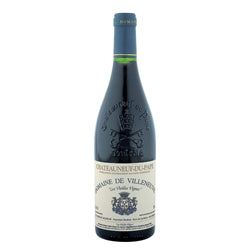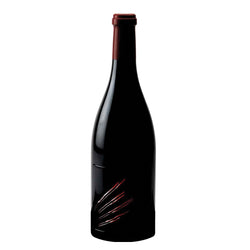Domaine de Villeneuve si trova pochi chilometri a sud del comune di Orange, nella Valle del Rodano, all’estremo settentrionale dell’appellation Châteauneuf-du-Pape. Il Domaine è stato acquistato nel 1993 da Roy de Blicquy e dalla famiglia Wallut che hanno recuperato vecchi vigneti e avviato la conversione all’agricoltura biodinamica già nel 1998. Dal 2004 il proprietario è Stanislas Wallut, responsabile in prima persona delle vinificazioni. La cantina è totalmente interrata su 2 livelli a più di 6 metri di profondità con 2 lati su 4 costruiti con grossi blocchi in pietra del Gard da 7,5 tonnellate: in questo modo, oltre al vantaggio di regolare naturalmente temperatura e umidità, l’uva viene lavorata per gravità (sia intera, sia diraspata o pigiata) evitando l’uso delle pompe. La cuverie vede sole vasche in cemento ideali per isolare in un clima molto caldo come quello del Rodano meridionale. Il lavoro minuzioso di Stanislas, l’applicazione delle pratiche biodinamiche in vigna, le piante antiche ad alberello (che raggiungono anche i cento anni) così come la lavorazione gentile (diraspatura con leggerissima pigiatura) e non invasiva (rimontaggi delicati senza estrazione, eseguiti unicamente per favorire l’infusione di bucce e vinaccioli) delle uve si traducono in vini di incredibile finezza ed eleganza, capaci di stupire per purezza e complessità e quindi esattamente all’opposto della maggior parte dei vini di Chateauneuf-du-Pape, votati alla grande estrazione e concentrazione.
Domaine de Villeneuve si trova pochi chilometri a sud del comune di Orange, nella Valle del Rodano, all’estremo settentrionale dell’appellation Châteauneuf-du-Pape. Il Domaine è stato acquistato nel 1993 da Roy de Blicquy e dalla famiglia Wallut che hanno recuperato vecchi vigneti e avviato la conversione all’agricoltura biodinamica già nel 1998. Dal 2004 il proprietario è Stanislas Wallut, responsabile in prima persona delle vinificazioni. La cantina è totalmente interrata su 2 livelli a più di 6 metri di profondità con 2 lati su 4 costruiti con grossi blocchi in pietra del Gard da 7,5 tonnellate: in questo modo, oltre al vantaggio di regolare naturalmente temperatura e umidità, l’uva viene lavorata per gravità (sia intera, sia diraspata o pigiata) evitando l’uso delle pompe. La cuverie vede sole vasche in cemento ideali per isolare in un clima molto caldo come quello del Rodano meridionale. Il lavoro minuzioso di Stanislas, l’applicazione delle pratiche biodinamiche in vigna, le piante antiche ad alberello (che raggiungono anche i cento anni) così come la lavorazione gentile (diraspatura con leggerissima pigiatura) e non invasiva (rimontaggi delicati senza estrazione, eseguiti unicamente per favorire l’infusione di bucce e vinaccioli) delle uve si traducono in vini di incredibile finezza ed eleganza, capaci di stupire per purezza e complessità e quindi esattamente all’opposto della maggior parte dei vini di Chateauneuf-du-Pape, votati alla grande estrazione e concentrazione.




